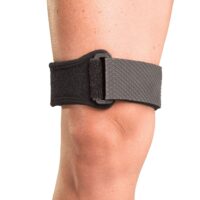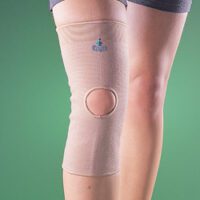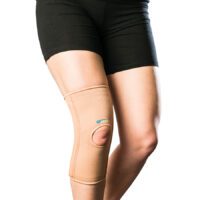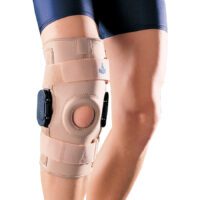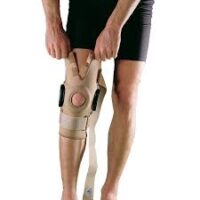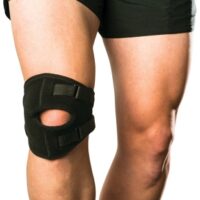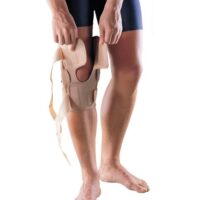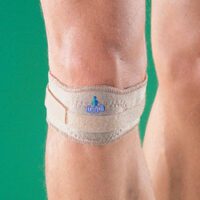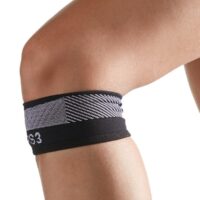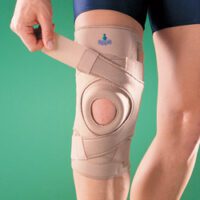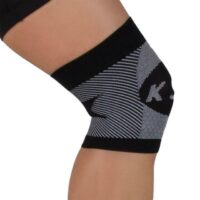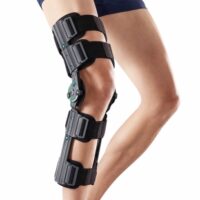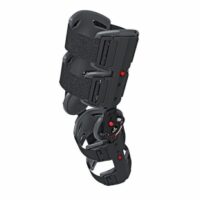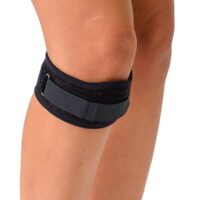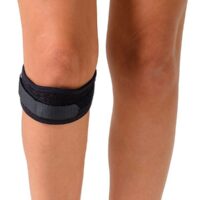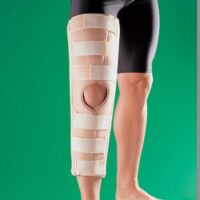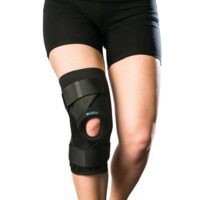Plica Syndrome
Article by John Miller

Plica Syndrome
What Causes Plica Syndrome?
Plica syndrome occurs when the medial plica in your knee becomes inflamed and irritated. This irritation can be caused by repetitive overuse or trauma to the knee. It can also occur due to incorrect alignment or movement of the patella, which can cause the plica to rub against the bone.
What is Plica Syndrome?
Plica syndrome occurs when the plica in your knee becomes inflamed. The plica is a fold of synovial membrane located in the anteromedial aspect of the knee. It is present in about 50% of the population and is a remnant of embryonic connective tissue that did not fully resorb during fetal development. While your knee may have four plicae, the medial plica is most likely to be symptomatic.
What are the Symptoms of Plica Syndrome?
If you have plica syndrome, the inflamed plica in your knee may catch during repetitive knee straightening and bending, blunt trauma or knee twisting, fat pad irritation, altered knee motion, or internal knee derangements such as meniscal tears. This can result in persistent knee pain and weakness in the quadriceps muscles. Plica syndrome often occurs concurrently with other knee conditions, such as meniscal injuries, patellar tendinopathy, and Osgood-Schlatter’s Disease.
Common symptoms of plica syndrome include pain and discomfort in your knee, which may worsen with activities such as running or climbing stairs. You may also experience a clicking or popping sensation in your knee. To diagnose plica syndrome, your doctor may check for anteromedial knee joint line pain, visible and palpably tender plica, or an audible clicking or snap during knee motion, which is painful between 30 to 60 degrees (Dupont, 1997). Additionally, a positive duvet test, where the pain is eased by using a duvet between your knees to ease the pain in bed, may also indicate plica syndrome. Activities such as ascending and descending stairs, squatting, rising from a chair, or sitting for extended periods can also cause pain (Shetty et al., 2007). Quadriceps atrophy is common in chronic cases.
How is Plica Syndrome Diagnosed?
Your physiotherapist or sports doctor can diagnose plica syndrome through a clinical examination. However, it is essential to have your knee thoroughly assessed to rule out other knee pathologies, particularly meniscal injuries.
While an X-ray may be helpful in ruling out associated pathologies, it will not identify a plica. MRIs can detect plica inflammation but are more helpful in diagnosing other pathologies related to plica irritation. Thus, a comprehensive examination by your physiotherapist or sports physician is preferable for accurate diagnosis.
Plica Syndrome Treatment
The treatment for plica syndrome involves reducing inflammation and pain through rest, ice, compression, and elevation. Physiotherapy can help correct any alignment or movement issues contributing to the condition. In severe cases, surgery may be required to remove the affected plica.
Research indicates that around 60% of patients with plica syndrome will recover successfully with conservative physiotherapy treatment within 6 to 8 weeks. The physiotherapy treatment aims to reduce pain and inflammation, improve patellofemoral alignment, normalise muscle lengths, strengthen the knee and lower limb muscles, address foot biomechanics issues, improve proprioception, agility and balance, and enhance lower limb function and quality of movement.
After a thorough examination, it is essential to discuss your knee injury with a knee clinician such as a physiotherapist, sports physician or knee surgeon. This approach can minimise the chances of re-aggravating your plica syndrome.
Plica Surgery
Consider undergoing arthroscopic knee surgery to treat plica syndrome that persists beyond 3 to 6 months. The surgery involves performing a lateral retinaculum release to allow the patella to track more medially, which can alleviate plica irritation as it rolls over the medial femoral condyle. The surgery has a success rate exceeding 85%. (Gerbino et al. 2007).
How to Prevent Plica Syndrome?
It is essential to take proactive measures to manage knee injuries. This includes maintaining normal knee joint alignment, adequate strength and flexibility in the muscles around the knee joint and the rest of the lower limb, wearing appropriate footwear that supports foot biomechanics, and considering weight management as a long-term preventative measure to reduce pressure on lower limb joints.
Patients with plica irritation may try using a knee brace to alleviate pain. An effective patellofemoral brace can be a helpful alternative to kneecap taping.
Knee Pain Causes
A Comprehensive Guide
Knee pain is often a symptom of underlying issues ranging from acute injuries to systemic health conditions. Identifying knee pain causes is essential for effective treatment. This guide offers an overview of potential culprits, providing a pathway to understanding and addressing your knee discomfort.


Knee Ligament Injuries
Ligament injuries, such as ACL and PCL tears, are significant knee pain causes. They can lead to instability and severe discomfort, requiring prompt medical evaluation.
- ACL Injury
- PCL Injury
- MCL Sprain
- LCL Sprain
- Posterolateral Corner Injury
- Superior Tibiofibular Joint Sprain
- Symptoms of a Torn Ligament
- Walking with a Torn Ligament
ACL Injuries
An ACL injury is a common sports-related knee injury that can lead to long-term knee pain and require surgical intervention.
- Is Surgery Needed?
- Living Without an ACL
- Main Function of the ACL
- Untreated ACL Injury
- Symptoms of an ACL Tear
- Diagnosing an ACL Tear
- Best Surgery for ACL Tear
- Post-ACL Reconstruction Rehabilitation
Knee Meniscus Injuries
Meniscus tears, often caused by twisting or turning quickly, are prevalent knee pain causes, with treatment options varying based on severity.
Kneecap Pain
Pain in the kneecap can arise from various conditions, affecting your ability to engage in daily activities comfortably.
- Chondromalacia Patella
- Fat Pad Syndrome
- Patella Dislocation
- Patellofemoral Pain Syndrome
- Patellar Tendinopathy
- Quadriceps Tendinopathy
- Osgood Schlatter’s Disease
- Sinding Larsen Johansson Syndrome
Knee Arthritis
Arthritis is a leading cause of knee pain, particularly in older adults, with symptoms that can significantly impair quality of life.
Knee Tendon Injuries
Tendon injuries can result from overuse or sudden, high-impact activities, contributing to ongoing knee pain.
Muscle Injuries
Muscle strains and related conditions are common knee pain causes, especially among athletes and active individuals.
- Corked Thigh
- Thigh Muscle Strain
- Hamstring Strain
- ITB Syndrome
- Popliteus Syndrome
- Muscle Strain
- Muscle Cramps
- DOMS – Delayed Onset Muscle Soreness
Knee Bursitis
Inflammation of the bursae can cause significant knee pain, often requiring targeted treatment to reduce symptoms.
Children’s Knee Conditions
Young athletes can experience specific knee conditions related to growth and activity levels.
Other Knee-Related Conditions
Various other conditions can lead to knee pain, necessitating a broad understanding of potential knee pain causes.
- Baker's Cyst
- Runner’s Knee
- Reducing Knee Stress for Runners
- Plica Syndrome
- Fibromyalgia
- Stress Fracture
- Overuse Injuries
- Restless Legs Syndrome
Knee Surgery
In some cases, surgical intervention may be the best option to address certain knee pain causes effectively.
Seek Professional Advice
For tailored information regarding your knee pain, consult a healthcare professional with experience in knee conditions, such as a knee physiotherapist, sports physician or knee surgeon. They can provide a personalised assessment and treatment plan to address your specific needs.
Knee Pain Products & FAQs
A variety of products can support knee pain management. Browse our selection and read our FAQs to learn more about how to alleviate knee discomfort. More info: Knee Pain Products & FAQs
With this guide, you’re better equipped to understand the various knee pain causes and take the first step towards recovery. Remember, early intervention by a skilled physiotherapist can significantly improve your outcomes and assist in returning you to a pain-free, active lifestyle.
Knee Pain FAQs
Knee pain is a widespread issue, impacting individuals of varying ages and lifestyles. Causes range from injuries and wear and tear to conditions like arthritis. This FAQ section aims to provide insights into knee pain, covering diagnosis, ligament issues, ACL injuries, meniscal injuries, age and arthritis concerns, and pain relief methods through exercise and treatment.
Feel free to click on the questions to for deeper discussions into each topic.


Diagnosis Related
How Can I Determine If My Knee Injury Is Serious?
- Learn to assess the severity of your knee injury based on symptoms and situations.
How Can I Identify The Type Of Knee Injury I Have?
- Discover how different knee injuries manifest and what signs to look for.
When Should I Seek a Physiotherapist or Doctor for My Knee Injury?
- Find out the right time to consult professionals for your knee concerns.
Is Knee Clicking a Sign of a Serious Condition?
- Understand what knee clicking indicates about your joint health.
When Should I Consider Getting a MRI for My Knee?
- Learn about the circumstances when an MRI becomes necessary.
Why Has My Knee Suddenly Started Hurting?
- Explore potential reasons behind sudden knee pain.
Why Does My Knee Hurt On The Inner Side?
- Identify causes of inner knee pain and when to seek help.
Knee Ligament Related
What Are The Common Symptoms of a Torn Ligament in the Knee?
- Recognise the signs of a torn knee ligament.
Can I Walk With A Torn Ligament In My Knee?
- Understand the feasibility and risks of walking with a torn ligament.
ACL Related
What are the Consequences of Not Getting Surgery for an ACL Injury?
- Learn about the long-term effects of untreated ACL injuries.
What Are The Symptoms Of An ACL Tear?
- Identify the key signs of an ACL tear.
Meniscus Related
Is Surgery Necessary for a Meniscal Injury?
- Discover when surgery is essential for meniscal injuries.
Can a Torn Meniscus Heal Without Surgery?
- Find out if meniscal tears can heal naturally.
Age & Arthritis Related
At What Age Do Knee Problems Typically Begin?
- Learn about the onset age for common knee problems.
What are the Common Symptoms of Arthritis in the Knee?
- Identify arthritis symptoms in the knee.
Running Related
What are Some Ways that Runners Can Reduce Knee Stress?
- Explore methods for runners to minimise knee stress.
Knee Treatment & Exercise Related
Is Walking Good For Knee Pain?
- Understand the benefits of walking for knee pain.
What are Some Effective Ways to Relieve Knee Pain?
- Discover various methods to alleviate knee pain.
How Much Walking is Recommended for Individuals with Knee Pain?
- Learn the ideal walking duration for those with knee pain.



